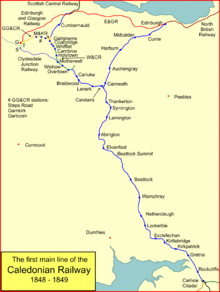History of the Caledonian Railway (until 1850)
The original route is a principal main line today, subject to the modifications approaching Glasgow, and later improved terminals there and in Edinburgh.
For some time the choice was between transport on the back of a pack animal—early roads were rarely stable enough for heavy wheeled vehicles—or on water, either a river or increasingly from the eighteenth century a canal.
The permanent way was cast iron fish-bellied rails on stone block "sleepers", and the track gauge was 4 ft 6 in (1,372 mm).
The critical issue was finding a route crossing, or going round, the high ground of the Southern Uplands and the Cheviot Hills and the Pennines.
Lancashire businessmen had been the driving force in many of the English railways, and as their plans already encompassed a network from London to Preston, their thoughts turned to reaching central Scotland.
In 1835 the Grand Junction Railway commissioned the young engineer Joseph Locke to propose routes from Glasgow to Carlisle.
Locke revised his survey the following year, finding that the worst gradients could be eased a little, but now money was suddenly hard to come by, and a proposed trunk railway was inopportune.
In 1839 a public meeting chaired by the Lord Provost of Glasgow decided to review the alternatives; but before the engineers' report could be assessed the Government decided to appoint its own commission, and Professor Peter Barlow of the Royal Military Academy at Woolwich, and Colonel Sir Frederick Smith, Inspector General of Railways at the Board of Trade, were appointed to "make recommendations on the most effective means of railway communication from London to Edinburgh, Glasgow and Dublin".
The Annandale route was favoured, but it was qualified: anyone could build such a line provided they gave an undertaking to reach Lancaster, at that time the northern extremity of planned English railways.
At Whifflat it joined the Wishaw and Coltness Railway, and the committee discussed the possibility of running over these lines to get access to Glasgow, and agreement with them was secured.
Strenuous efforts resulted in agreement with the Scottish Central to form a junction with them near Castlecary (west of Falkirk), and a branch to that point was added to the Caledonian proposals.
In fact the branch was complicated: the Caledonian already proposed to run over the Glasgow, Garnkirk and Coatbridge Railway (GG&CR) from Whifflat.
It was to connect the Wishaw and Coltness Motherwell and the south side of Glasgow, incorporating and upgrading an earlier horse-operated mineral line, the Polloc and Govan Railway.
The CJR would provide a more direct entry into Glasgow than the Garnkirk line, (and it was not certain that the former coal railways would give adequate precedence to express passenger trains over their mineral movements) so this was a useful ally to have.
On 27 January 1846 a working agreement with the GP&GR was finalised, and on the same day a lease was agreed with the Glasgow, Barrhead and Neilston Direct Railway.
While the proposal was obviously convenient for travellers, it aroused fierce opposition in the city, and the Admiralty demanded a swing bridge over the Clyde.
A general tightness of money made many of these unable to proceed to Parliament, or if authorised to be constructed, but the CR was anxious to complete its line; the several English railways that were to form the West Coast Route had consolidated under the title the London and North Western Railway (LNWR) and had reached Carlisle on 15 December 1846, adding to the feeling of urgency.
Adding to the frenzy of alliances, the Scottish Midland Junction Railway now came under notice; it had an authorised line northwards from Perth to Forfar, but having connectivity to several further destinations.
There were three trains each way daily, with onward coach connections for Glasgow and Edinburgh, giving a journey time to and from London of the order of 22 hours.
On 14 February 1848 the Directors were able to make a trial trip between Glasgow and Beattock, and the following day a full service started, with through coaches to and from London.
With the opening of the Scottish Midland Junction Railway main line on 20 August 1848, a through route from Dundee to London was available.
Many shareholders believed there was little chance of operating income paying off those charges, and when the Directors announced that they had leased the Dundee and Perth and Aberdeen Railway Junction Company there was an explosion of discontent.
Shareholders passed a vote of no confidence in their directors, but at a Special Meeting at Euston on 10 November the board secured a narrow majority of support.
In most cases the agreements had been to pay a fixed percentage on the capital of the leased company, and this represented an unbearable burden on the Caledonian's income.
In February 1850 matters came to a head; two bank debentures totally £245,000 were due for repayment, as well as considerable arrears of lease charges to the Wishaw and Coltness and others.
The Company now tried to stall the agreed merger with the Glasgow, Paisley and Greenock Railway, which was itself mired in controversy over financial irregularity.
It had expended much energy and money on securing alliances with other trunk routes, and its financial performance disappointed shareholders in the subsequent decades.
With its English partner, the London and North Western Railway, it formed a strong alliance, operating together as the West Coast Main Line, a term used to this day.
The climb to the summit at Beattock continued to be a daunting obstacle until electrification on 22 April 1974, since when the available traction power has diminished the problem.
On 1 November 1849 the line was extended from Milton Junction to Glasgow, Buchanan Street, and Townhead station became a goods depot.

